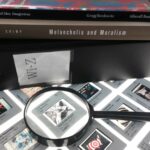Visual AIDS is thrilled to announce that MC Roodt will be our sixth annual Curatorial Resident, co-sponsored with Residency Unlimited. MC lives and works in Bloemfontein, South Africa and will coordinate an Arts & Health program and a transnational and online exhibition during his March residency with Visual AIDS in New York City. MC will spend the month conducting research in Visual AIDS' archives with access to slides, digital images, publications and other resources, as well as activating our community through dialogues, studio visits and a public program. Here, MC introduces himself and the stakes of his work to the Visual AIDS community. Welcome, MC!
I am an HIV positive arts practitioner, writer and artist from Bloemfontein, South Africa. I serve on various arts, health and culture boards, am a founding member of the gRRR Kollective—an intermedia arts collective—and have curated several exhibitions in South Africa. I frequently contribute as an arts writer on various platforms and am an active activist for LGBTQIA rights in South Africa. Currently, I am managing the first Arts and Health programme in my homeland, The Free State Arts and Health Programme. We support and design community-centered intermediations by arts-workers with the aim of positively impacting the health and well-being of the communities we work for. Using the arts, the programme engages communities in arts practices and projects that address key health aspirations, with a specific focus on HIV. In doing so, the Free State Arts and Health Programme endeavors to mobilize communities to improve their collective health, stimulate the growth of vibrant, comergent forms of artistic and cultural expression in Africa, and build new audiences and models of participation for works produced.
While in NYC, I will coordinate an Arts & Health Project Design Strategies workshop to introduce participants to the design of public Arts & Health projects, blending the practices of community arts and community health. The workshop will demonstrate to participants the value of interdisciplinary perspectives and partnerships in the realization of community health aspirations. The focus throughout will be on promoting inclusion and autonomy as a means to foster sustainable impact that is rooted in and affects community narratives.
I also intend to make use of my current partnership network to facilitate and showcase a transnational exhibition, presented on the Visual AIDS online platform, in South Africa at the annual Free State Arts Festival and discussions are on their way to replicate the exhibition model in Perth, Australia. The exhibition will explore different cultural responses to the HIV pandemic, with a specific curatorial focus on works that challenge isolation. Therefore the transnational model will include works from the Visual AIDS Artist+ Registry together with works from South Africa and Australia.
I come from sub-Saharan Africa. This region is still marked by the devastating effects of the HIV/AIDS pandemic approximately 35 years after it was identified. The latest statistics reflect that 12.6% of the population across South Africa is living with HIV. This percentage increases to over 14% in the province in which I live and work.
Denial, blame, corruption and invisibility are a few of the myriad factors contributing to the ongoing devastation in this area. As the infection rate rises, so does the upsurge of stigma that fractures our society. The reality of social isolation is visible in crippling scenes of despair in our hospitals wards and excommunication in our streets. The thread running through all of this, a dehumanising narrative of separation.
The irony embedded in this narrative is that everyone’s life is touched by this pandemic. HIV/AIDS is one of the factors that unify us, yet we choose to be indifferent and reject the notion of community in favour of an worldview based on indifference and above all individualism. We do even more so in relation to disease. Parallel to this rhetoric of difference runs an often ignored narrative of similarity, of interbeing in relation to HIV. Many of the artworks in the Visual AIDS Artist+ Registry demonstrate this, and this is the focus of my intent: To curate a show that disrupts the psychic substructure of a separate reality.
Currently, recontextualisations of the Visual AIDS Artist+ Regsitry rely on discourses such as queer theory and intersectionality. These frameworks often increase social isolation and contributes to subject stigmatisation. However, the South African context from whence I draw my lived experience highlights some of the antitheses of queer theory. This is largely due to the positioning of HIV/AIDS in Sub-Saharan Africa that moves the pandemic away from minority groups.
I intend to use this as a problem statement that will be addressed by augmenting queer theory with Charles Eisenstein’s ideas about Interbeing. It is important to note that the intention is not to critique queer theory but to elaborate on it in order to advance HIV/AIDS activism through the arts. Eisenstein’s latest appropriation of the Buddhist theory of Interbeing resonates with the Southern African philosophy of Ubuntu. Where Eisenstein’s work collapses empathy disrupting narratives of separation, Ubuntu, which translates as "people are people through other people," makes possible an application of HIV/AIDS activism that macro-scopes the societal interconnectedness between the HIV/AIDS community and society at large on an ontological level.
It is an honour to have been selected to participate in a residency hosted by an orginization that has not only inspired my profesional practice but one who’s also validated my own artistic practice immeasurably. I am humbled by their hospitality and look forward to connecting with a community of peers united by our shared experience of art, surviving and activism.


